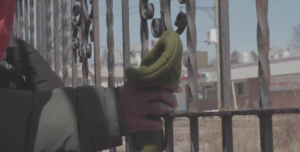12 Giu An interview with Sanjana Bhambhani, director of “Mr.Blanks”
BIO
It was Mr. Blanks’ drive to build a new life for himself – almost from scratch – at the age of 70 despite all the obstacles in his way, that drew me to his story.
I met Anthony Blanks when I was following prison advocacy groups to Albany to report on an elder parole bill. The bill – which advocates were in Albany to discuss with New York State legislators – would allow incarcerated persons age 55 and older who’d served at least 15 years of their sentence to appear before a parole board.
When Mr. Blanks and other elders shared their stories in Albany that day, I came to realize that his experiences felt at once representative of what elder parole looks like, and at the same time a more difficult case in some respects as he didn’t have the familial support or familiarity with his parole city that others may have had. His story highlighted both the common and added struggles faced by elders on parole.
What’s more, despite medical concerns and the fact that he was just three months into adjusting to a technology-centred life in a city he was unfamiliar with (he’s from St. Louis, MO), Mr. Blanks travelled three hours on a bus to advocate for the rights of others in his position. He was on a journey to both supporting himself and other parolees and I wanted to document that.

I’d preface this by saying that this was my first short film made alone and I’m sure there’s much I still have to learn. But I can share with you some of the steps I took to tell the story with as much care and sensitivity as I knew to.
Before I ever began filming Mr. Blanks, I spent time just observing and learning about him and what he was experiencing during re-entry. He invited me to sit in on Community Meetings at his transitional housing facility where I spoke with workers and other residents (several of whom were also formerly incarcerated). I read copies of the news articles on his case that he’d saved over the years, and I spoke with him at length over several weeks on the phone and in-person. He was generous to lend me so much of his time even before we started filming and it really helped me think about what aspects of his struggle could be shown in the film, logistically, and more importantly, without putting his safety at risk.
In that time, Mr. Blanks went out of his way to make in-facility interviews possible, had me meet with important administrators in his housing to get the appropriate permissions and discuss the issue with leading advocates in the community.
This was especially important — that he really wanted to be part of this project — because my conversations in advocacy spaces re-iterated how physically, psychologically and emotionally damaging incarceration can be and the last thing I’d want is to have someone who doesn’t feel in a position to or want to think about and share their struggles, do so on camera.
As I was starting to film Mr. Blanks, he would share with me what he was doing throughout the week and I would ask if I could come along and film. I communicated that if he ever felt it would be overwhelming for me to follow him during a certain trip – especially since he is often doing sensitive tasks like going to the social security office or meeting with his parole officer – I wouldn’t come along. His safety, comfort and well-being came first, of course.
Still, he seemed open to having me follow him most places. In fact, we had once scheduled an interview at his housing facility and when I arrived, he had to make a sudden trip to the pharmacy (the one we see in the film). He asked if I wouldn’t mind coming along and filming that first instead, so that’s what I did. I hope that scene in the pharmacy helped audiences learn more about the medical and financial struggles of elderly parolees.

You may notice that the film begins with, ends with and follows Mr. Blanks on a walk. He takes us along on his journey both literally and metaphorically. A lot of the scenes where we hear him share his hopes occur as we see him on that walk. That walk is actually one he takes to be away from his everyday life for a bit, to think. You’ll see, on the flip side, that some of his hardest moments are filmed indoors, in more closed spaces. These were some of the decisions made to complement and visualize the emotions behind Mr. Blanks’ words.
As for how my background influenced the narrative choices, I’m not sure. Perhaps it’s something I’ll learn more about as I continue down the documentary path.

The choice not to focus on what the protagonist did before imprisonment, thus on his past, but only on the aftermath, is very brave and politically relevant. What impact do you hope ‘Mr. Blanks’ will have on audiences and policymakers, particularly in terms of changing perceptions or influencing reforms?
I set out to make a short documentary about the barriers to re-entry experienced by elderly parolees. The details of the crime Mr. Blanks committed before he was incarcerated, I would think, should have no bearing on the support he receives while on parole. He served his sentence, and faced almost two dozen parole boards, the final of which determined that he was fit to re-enter society. So I didn’t think that focusing on what Mr. Blanks did before imprisonment would be relevant to the experience I set out to share, namely, his life on parole.
Audiences will inevitably come away from ‘Mr.Blanks’ with various different perspectives on elderly parole, coloured by their own lived experiences, but my hope is that, at the very least, they leave with a better sense of what life on parole looks like for the elderly.



